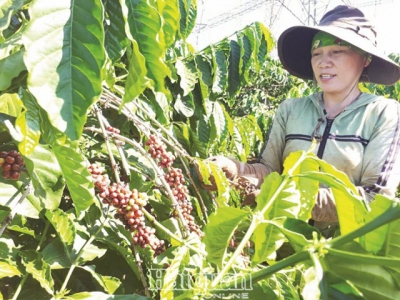Export of coffee: quantity ranks second, price ranks last

Although exports of coffee ranked second in the world, for many years the export value has not been commensurate with the potential.
The value of coffee exports has now decreased by more than 20% over the same period last year. Photo: N. Thanh.
Strongly reducing in both quantity and value
According to the Department of Agricultural Product Processing and Market Development (MARD),in the first 8 months of this year, coffee exports were estimated at 1.17 million tons and nearly US$2 billion, down 11.8% in volume and down 21.4% in value over the same period in 2018.
In the first 7 months of the year, Germany and the US continued to be the two largest coffee consuming markets of Vietnam with market shares of 13.7% and 9% respectively. Except for the two markets of Philippines and Malaysia with an increase in coffee export value (up 22.1% and 3.7%, respectively), most of the main markets decreased compared to the same period in 2018. Average export coffee price in the first 7 months of the year only reached US$1,708 per ton, down 11.2% compared to the same period in 2018.
Although standing in second position in the world, Vietnam's export coffee price is quite modest, often in last position. The best example of this is the case of exporting coffee to Australia.
Vietnam is now the second largest source of coffee for Australia, after Brazil. According to statistics from the International Trade Center (ITC), Australia's coffee imports in the first half of this year reached 52.3 thousand tons, worth US$222.81 million, up 5.7% in volume and 1% in value compared to the same period last year.
Regarding import prices, the import price of Australian coffee from Vietnam was the lowest among the supply, reaching only US$1,834 per ton. Meanwhile, import prices from other markets are as follows: from Brazil reached US$2,809/ton, Colombia reached US$3,687/ton, Indonesia reached US$4,565/ton. Up to now, Vietnamese coffee exporting enterprises have not been proactively setting prices. This price is driven by coffee exchanges in London or New York.
Improve quality, create brands
Why is the price of Vietnamese coffee constantly falling? From the beginning of the year until now, the answer is that the price decreases according to the global price decrease. The Department of Processing and Agricultural Product Market Development states: In the world market, in August, the price of coffee fluctuated. Compared to August, the price of Robusta coffee delivered in September decreased US$41 to US$1,297/ton. World coffee prices continued to decline in the first months of 2019 and fell to the lowest level in the past 13 years due to oversupply pressure of the global coffee market.
Thisis a superficial andobjective cause. Subjectively, the factor that makes Vietnam's export price of coffee stuck in the long term, according to Nguyen Nam Hai, Permanent Vice Chairman of Vietnam Coffee and Cocoa Association, is because Vietnamese coffee is mainly exports (accounting for more than 80% of export volume). In addition, raw coffee harvest does not meet the standards of ripenessand impurities lead to low quality.
Do Kim Lang, Deputy Director of the Trade Promotion Department (Ministry of Industry and Trade) also assessed that Vietnam mainly produces and exports green coffee, which does not bring high added value. The world knows Vietnam exports coffee, but in fact does not know Vietnamese coffee. Some brands such as Trung Nguyen and Nguyen Tranghave brought their own export coffee to international markets, but most of the markets are not globally competitive, even Vietnamese coffee has not yet participated inglobal value chains.
In order to improve the export value of coffee and ensure the sustainable development of the industry, many experts have agreed that, firstly, it is necessary to improve the quality of coffee at the stage of harvesting, drying, and classifying. Accordingly, it is necessary to implement synchronous measures such as attracting coffee processing enterprises to invest in key coffee-growing areas, intensifying agricultural extension, encouraging people to apply techniques to ensure standards in harvesting, drying and grading stages. The Government should promote attracting foreign investment in terms of capital, science and technology to build processing factories for export.
Besides, the trend of consumers in the world always using branded products and geographical indications, so the branding stage for Vietnamese coffee is indispensable. Specifically, it is necessary to actively promote building and promoting Vietnam's coffee brand into a national product globally; encourage the development of private brands of coffee to bring to the world market.
Có thể bạn quan tâm
 Successful, small-scale organic farming in the city
Successful, small-scale organic farming in the city Organic farmer Geoffrey Green of Sparrow Village Farm has created a farming operation on just 0,4ha of land in Maraisburg, Gauteng.
 Coffee exports down in 9 months
Coffee exports down in 9 months Việt Nam’s coffee exports in the first nine months of this year fell by 13.3 per cent in volume to 1.25 million tonnes and 21.9 per cent in value
 Sustainable production sought for dragon fruit as China raises import standards
Sustainable production sought for dragon fruit as China raises import standards Proper zoning and more investment for processing are among the measures needed to develop sustainable production of dragon fruit in the country